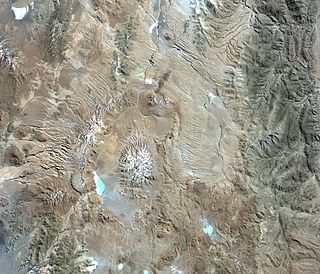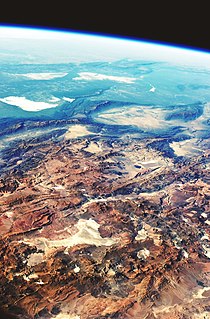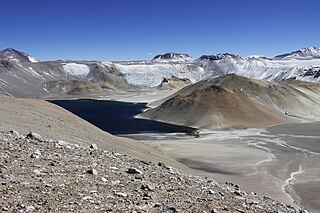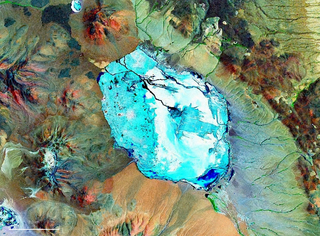Related Research Articles

Cerro El Cóndor is a stratovolcano in Argentina.

Cerro Galán is a caldera in the Catamarca Province of Argentina. It is one of the largest exposed calderas in the world and forms part of the Central Volcanic Zone of the Andes, one of the three volcanic belts found in South America. One of several major caldera systems in the Central Volcanic Zone, the mountain is grouped into the Altiplano–Puna volcanic complex.

Cordón de Puntas Negras is a 500 km2 (193 sq mi) volcanic chain located east of the Salar de Atacama in Chile's Antofagasta Region.

La Pacana is a Miocene age caldera in northern Chile's Antofagasta Region. Part of the Central Volcanic Zone of the Andes, it is part of the Altiplano-Puna volcanic complex, a major caldera and silicic ignimbrite volcanic field. This volcanic field is located in remote regions at the Zapaleri tripoint between Chile, Bolivia and Argentina.
Aguas Calientes is a major Miocene caldera in Salta Province, Argentina. It is in the Central Volcanic Zone of the Andes, a zone of volcanism covering southern Peru, Bolivia, northwest Argentina and northern Chile. This zone contains stratovolcanoes and calderas.

The Altiplano–Puna volcanic complex, also known as APVC, is a complex of volcanic systems in the Puna of the Andes. It is located in the Altiplano area, a highland bounded by the Bolivian Cordillera Real in the east and by the main chain of the Andes, the Western Cordillera, in the west. It results from the subduction of the Nazca Plate beneath the South American Plate. Melts caused by subduction have generated the volcanoes of the Andean Volcanic Belt including the APVC. The volcanic province is located between 21° S–24° S latitude. The APVC spans the countries of Argentina, Bolivia and Chile.
Cerro Guacha is a Miocene caldera in southwestern Bolivia's Sur Lípez Province. Part of the volcanic system of the Andes, it is considered to be part of the Central Volcanic Zone (CVZ), one of the three volcanic arcs of the Andes, and its associated Altiplano-Puna volcanic complex (APVC). A number of volcanic calderas occur within the latter.

Panizos is a Late Miocene caldera in the Potosí Department of Bolivia and the Jujuy Province of Argentina. It is part of the Altiplano-Puna volcanic complex of the Central Volcanic Zone in the Andes. 50 volcanoes active in recent times are found in the Central Volcanic Zone, and several major caldera complexes are situated in the area. The caldera is located in a difficult-to-access part of the Andes.
The Caldera Lauca is a caldera in the Arica y Parinacota Region of Chile. It is located in the Cordillera Occidental, in the valley of the Lauca River. The elliptic caldera has an east-west extension of 23 kilometres (14 mi) and 50 kilometres (31 mi) in north-south direction, buried beneath the late Miocene Vilañuñumani-Tejene volcanic complex in the north and ending at Chucal in the south. The 21 mya Oxaya Ignimbrite originates in the caldera. The eastern border of the caldera is buried beneath younger ignimbrites and deposits but is located east of the Guallatiri volcano. An Oligocene fault marks the western edge of the caldera.
Coranzuli is a back-arc caldera in the Andes, related to the Altiplano-Puna volcanic complex.

Incapillo is a Pleistocene caldera, a depression formed by the collapse of a volcano, in the La Rioja province of Argentina. Part of the Argentine Andes, it is considered the southernmost volcanic centre in the Central Volcanic Zone of the Andes with Pleistocene activity. Incapillo is one of several ignimbritic or calderic systems that, along with 44 active stratovolcanoes, are part of the Central Volcanic Zone.
Jotabeche is a Miocene-Pliocene caldera in the Atacama Region of Chile. It is part of the volcanic Andes, more specifically of the extreme southern end of the Central Volcanic Zone (CVZ). This sector of the Andean Volcanic Belt contains about 44 volcanic centres and numerous more minor volcanic systems, as well as some caldera and ignimbrite systems. Jotabeche is located in a now inactive segment of the CVZ, the Maricunga Belt.
Kari-Kari is a Miocene caldera in the Potosi department, Bolivia. It is part of the El Fraile ignimbrite field of the Central Volcanic Zone of the Andes. Volcanic activity in the Central Volcanic Zone has generated 44 volcanic centres with postglacial activity and a number of calderas, including the Altiplano-Puna volcanic complex.
Laguna Amarga is a caldera and associated ignimbrite in the Andes of northwestern Argentina.
Los Colorados is the name of a caldera in Chile. It is part of the Central Volcanic Zone of the Andes.
Luingo is a caldera in the Andes of Argentina. It is located southeast of the Galan caldera. The caldera is not recognizable from satellite images and is associated with the Pucarilla-Cerro Tipillas volcanic complex.

Negra Muerta is a caldera in Argentina. It is part of the volcanic centres of the Andean Volcanic Belt, which has formed a number of calderas in large ignimbrite producing eruptions. These calderas include Aguas Calientes, Cerro Panizos, Galan, Negra Muerta and La Pacana. Some of these volcanic centres appear to be associated with large fault zones that cross the Puna.

Pastos Grandes is the name of a caldera and its crater lake in Bolivia. The caldera is part of the Altiplano-Puna volcanic complex, a large ignimbrite province that is part of the Central Volcanic Zone of the Andes. Pastos Grandes has erupted a number of ignimbrites through its history, some of which exceeded a volume of 1,000 cubic kilometres (240 cu mi). After the ignimbrite phase, the lava domes of the Cerro Chascon-Runtu Jarita complex were erupted close to the caldera and along faults.
Wheelwright caldera is a caldera in Chile. It is variously described as being between 11 kilometres (6.8 mi) and 22 kilometres (14 mi) wide and lies in the Central Volcanic Zone of the Andes. A lake lies within the caldera, which is among the largest of the Central Andes. The caldera lies in the region of Ojos del Salado, the world's tallest volcano.
Vilama is a Miocene caldera in Bolivia and Argentina. Straddling the border between the two countries, it is part of the Central Volcanic Zone, one of the four volcanic belts in the Andes. Vilama is remote and forms part of the Altiplano-Puna volcanic complex, a province of large calderas and associated ignimbrites that were active since about 8 million years ago, sometimes in the form of supervolcanoes.
References
- ↑ Riller, Ulrich; Petrinovic, Ivan; Ramelow, Juliane; Strecker, Manfred; Oncken, Onno (June 2001). "Late Cenozoic tectonism, collapse caldera and plateau formation in the central Andes". Earth and Planetary Science Letters. 188 (3–4): 299–311. doi:10.1016/S0012-821X(01)00333-8.
- ↑ Naranjo, José Antonio; Villa, Víctor; Ramírez, Cristián; Pérez de Arce, Carlos. "Oligo - Holocene evolution of the southern part of the Central Andes: volcanism and tectonic" (PDF). biblioserver.sernageomin.cl. SERNAGEOMIN. Archived from the original (PDF) on 6 April 2017. Retrieved 21 June 2016.